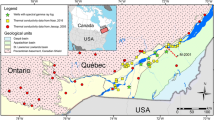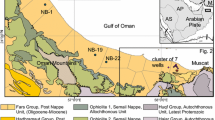Abstract
Heat flow has been determined by combining temperature measurements in 7 boreholes with thermal conductivity measurements in the Upper Vindhyan sedimentary rocks of Shivpuri area, central India. The boreholes are distributed at 5 sites within an area of 15 × 10 km2; their depths range from 174 to 268 m. Geothermal gradients estimated from borehole temperature profiles vary from 8.0–12.7 mK m−1 in the sandstone-rich formations to 25.5–27.5 mK m−1 in the shale-rich formations, consistent with the contrast in thermal conductivities of the two rock types. Heat flow in the area ranges between 45 and 61 mW m−2, with a mean of 52±6 mW m−2. The heat flow values are similar to the >50 mW m−2 heat flow observed in other parts of the northern Indian shield. The heat flow determinations represent the steady-state heat flow because, the thermal transients associated with the initial rifting, convergence and sedimentation in the basin as well as the more recent Deccan volcanism that affected the region to the south of the basin would have decayed, and therefore, the heat flow is in equilibrium with the radiogenic heat production of the crust and the heat flow from the mantle. The present study reports the heat flow measurements from the western part of the Vindhyan basin and provides heat flow information for the Bundhelkhand craton for the first time. Radioelement (Th, U and K) abundances have been measured both in the sedimentary rocks exposed in the area as well as in the underlying basement granite-gneiss of Bundelkhand massif exposed in the adjacent area. Radioactive heat production, estimated from those abundances, indicate mean values of 0.3 μW m−3 for sandstone with inter-bands of shale and siltstone, 0.25 μW m−3 for sandstone with inter-bands siltstone, 0.6 μW m−3 for quartzose sandstone, and 2.7 μW m−3 for the basement granitoids. With a total sedimentary thickness not exceeding a few hundred metres in the area, the heat production of the sedimentary cover would be insignificant. The radioactive heat contribution from the basement granitoids in the upper crust is expected to be large, and together with the heat flow component from the mantle, would control the crustal thermal structure in the region.
Similar content being viewed by others
References
Birch, F. (1954) Heat from Radioactivity. In: H. Faul (Ed.), Nuclear Geology. Wiley & Sons, New York, pp.148–174.
Biswas, S.K. (1987) Regional tectonic framework, structure and evolution of western marginal basins of India, Tectonophysics, v.135, pp.307–327.
Blackwell, D. D. and Steele, J. L. (1988) Thermal conductivity of sedimentary rocks — measurement and significance. In: N.D. Naeser and T.H. McCulloh (Eds.), Thermal History of Sedimentary Basins-Methods and Case Histories. Springer-Verlag, Berlin, pp.13–36.
Bose, P K., Sarkar, S., Chakrabarty, S. and Banerjee, S. (2001) Overview of the Meso to Neoproterozoic evolution of the Vindhyan basin, central India. Sedimentary Geol., v.141, pp.395–419.
Cermak, V. and Rybach, L. (1982) Thermal conductivity and specific heat of minerals and rocks. In: G. Angenheister (Ed.), Physical Properties of Rocks, Sub Vol. a, Geophysics and Space Research, Group V, Springer-Verlag, Berlin, pp.305–341.
Chakraborty, C. (2006) Proterozoic intracontinental basin: The Vindhyan example. Jour. Earth System Sci., v.115, pp.3–22.
Chakraborty, C. and Bhattacharyya, A. (1996) The Vindhyan basin: An overview in the light of current perspectives. Mem. Geol. Soc. India, No.36, pp.301–312.
Chaudhuri, A.K., Saha, D., Deb, G.K., Deb, S.P., Mukherjee, M.K. and Ghosh, G. (2002) The Purana basins of southern cratonic province of India — A case for Mesoproterozoic fossil rifts. Gondwana Res., v.5, pp. 23–33.
GSI (1998) Geological Map of India, scale 1:2,000,000.
GSI (2003) Geological Quadrangle Map (54G), Shivpuri Quadrangle, Madhya Pradesh and Rajasthan, scale 1:2,50,000.
GSI-NGRI (2006) Bouguer anomaly map of India. Published by Geological Survey of India and National Geophysical Research Institute, Hyderabad, India.
Gupta, M.L., Verma, R.K., Hamza, V.M., Rao, G.V. and Rao, R.U.M. (1970) Terrestrial heat flow and tectonics of the Cambay basin, Gujarat state, India. Tectonophysics, v.10, pp.147–163.
Kaila, K.L., Murthy, P. R. K. and Mall D. M. (1989) The evolution of the Vindhyan basin vis-a-vis the Narmada-Son lineament, Central India, from deep seismic soundings. Tectonophysics, v.162, pp.277–289.
Kumar, A., Gopalan, K. and Rajagopalan G (2001) Age of the Lower Vindhyan sediments, Central India. Curr. Sci., v.81, pp.806–809.
Kumar, A., Kumari, P., Dayal, A. M., Murthy, D.S.N. and Gopalan, K. (1993) Rb-Sr ages of Proterozoic kimberlites of India: evidence for contemporaneous emplacements. Precambrian Res., v.62, pp.227–237.
Kumar, S. and Srivastava, P. (1997) A note on the carbonaceous megafossils from the Neoproterozoic Bhander Group, Maihar area, Madhya Pradesh. Jour. Pal. Soc. India, v.42, pp. 141–146.
Lachenbruch, A.H. and Sass, J.H. (1978) Heat flow in the United States and the thermal regime of the crust. In: J.G. Heacock (Ed.), The Earth’s crust: Its Nature and Physical Properties. Geophys. Monogr. Ser. no.20, AGU, Washington D.C., pp.626–675
Mishra, D.C. (2011) Long hiatus in Proterozoic sedimentation in India: Vindhyan, Cuddapah and Pakhal Basins — A Plate Tectonic Model. Jour. Geol. Soc. India, v.77, pp.17–25.
Rai, V., Shukla, M. and Gautam, R. (1997) Discovery of carbonaceous megafossils (Chuaria-Tawuia assemblage) from the Neoproterozoic Vindhyan succession (Rewa Group), Allahabad-Rewa area, India. Curr. Sci., v.73, pp.783–788.
Rajendra Prasad, B. and Vijaya Rao, V. (2006) Deep seismic reflection study over the Vindhyans of Rajasthan: implications for the geophysical setting of the basin. Jour. Earth System Sci., v. 115, pp.135–147.
Ram, J., Shukla, S.N., Pramanik, A.G., Varma, B.K., Chandra, G. and Murthy, M.S.N. (1996) Recent investigations in the Vindhyan basin: implications for basin tectonics. Mem. Geol. Soc. India, no.36, pp.267–286.
Ramakrishnan, M. and Vaidyanathan, R. (2008) Geology of India. Geol.Soc.India, volume, 556p.
Rao, G.V. and Rao, R.U.M. (1980) A geothermal study of the Jharia Gondwana Basin (India): Heat flow results from several holes and heat production of basement rocks. Earth Planet. Sci. Lett., v.48, pp.397–405.
Rao, G.V. and Rao, R.U.M. (1983) Heat flow in the Indian Gondwana basins and heat production of their basement rocks. Tectonophysics, v. 91, pp.105–117.
Rao, R.U.M. and Rao, G.V. (1974) Results of some geothermal studies in Singbhum Thrust Belt, India. Geothermics, v.3, pp.153–161.
Rao, R.U.M., Roy, S. and Srinivasan, R., (2003) Heat-flow researches in India: results and perspectives. In: Mahadevan, T.M., Arora, B.R. and Gupta, K.R., Eds., Indian Continental Lithosphere, Emerging Research Trends. Mem. Geol. Soc. India, no.53, pp.347–391.
Rao, R.U.M., Verma, R.K., Rao, G.V., Hamza, V.M. and Gupta, M.L. (1970) Heat flow at Damua and Mahapani, Satpura Gondwana Basin, India. Earth Planet. Sci. Lett., v.7, pp. 406–412.
Rasmussen, B., Bose, P.K., Sarkar, S., Banerjee, S., Fletcher, I. R. and Mcnaughton, N.J. (2002) 1.6Ga U-Pb zircon age for the Chorhat Sandstone, Lower Vindhyan, India: possible implications for early evolution of animals. Geology, v.30, pp.103–106.
Ray, J.S. (2006) Age of the Vindhyan supergroup: A review of recent findings. Jour. Earth System Sci., v.115, pp.149–160.
Ray, J.S., Veizer, J. and Davis, W.J. (2003) C, O, Sr and Pb isotope systematics of carbonate sequences of the Vindhyan Supergroup, India: age, diagenesis, correlations and implications for global events. Precambrian Res., v.121, pp.103–140.
Ray, L., Kumar, P.S., Reddy, G.K., Roy, S., Rao, G.V., Srinivasan, R., and Rao, R.U.M. (2003) High mantle heat flow in a Precambrian granulite province: Evidence from southern India. Jour. Geophys. Res., 108(B2), 2084, doi:10.1029/2001JB000688.
Roy, S. and Mareschal, J.C. (2011) Constraints on the deep thermal structure of the Dharwar craton, India, from heat flow, shear wave velocities, and mantle xenoliths. Jour. Geophys. Res., v.116, B02409, doi: 10.1029/2010JB007796.
Roy, S. and Rao, R. U. M. (2000) Heat flow in the Indian shield. Jour. Geophys. Res., v. 105, 25,587–25,604, doi: 10.1029/2000JB900257.
Roy, S. and Rao, R.U.M. (2003) Towards a crustal thermal model for the Archaean Dharwar craton, southern India. Phys. Chem. Earth., v.28, pp.361–373, doi:10.1016/S1474-7065(03)00058-5.
Roy, S., Harris, R.N., Rao, R.U.M. and Chapman, D.S. (2002) Climate change in India inferred from geothermal observations. Jour. Geophys. Res., v.107, doi:10.1029/2001JB000536.
Sarangi, S., Gopalan, K. and Kumar, S. (2004) Pb-Pb age of earliest megascopic eukaryotic algae bearing Rohtas Formation, Vindhyan Supergroup, India: Implications for Precambrian atmospheric oxygen evolution. Precambrian Res., v.132, pp.107–121.
Sass, J.H. and Lachenbruch, A.H. (1979) Thermal regime of the Australian continental crust. In: M.W. McElhinny (Ed.), The Earth: Its Origin, Structure and Evolution. Academic, San Diego, Calif., pp.301–351.
Scholz, C.H. (1998) Earthquakes and friction laws. Nature, v.391, pp. 37–41.
Srivastava, B.N., Rana, M.S. and Verma, N.K. (1983) Geology, hydrocarbon prospects of the Vindhyan basin. Petroleum Asia Jour., v.1, pp.179–189.
Verma, R.K. (1991) Geodynamics of the Indian Peninsula and the Indian Plate Margin. Oxford and IBH, 357p.
Author information
Authors and Affiliations
Corresponding author
Rights and permissions
About this article
Cite this article
Nagaraju, P., Ray, L., Ravi, G. et al. Geothermal investigations in the Upper Vindhyan sedimentary rocks of Shivpuri area, central India. J Geol Soc India 80, 39–47 (2012). https://doi.org/10.1007/s12594-012-0116-x
Received:
Accepted:
Published:
Issue Date:
DOI: https://doi.org/10.1007/s12594-012-0116-x




